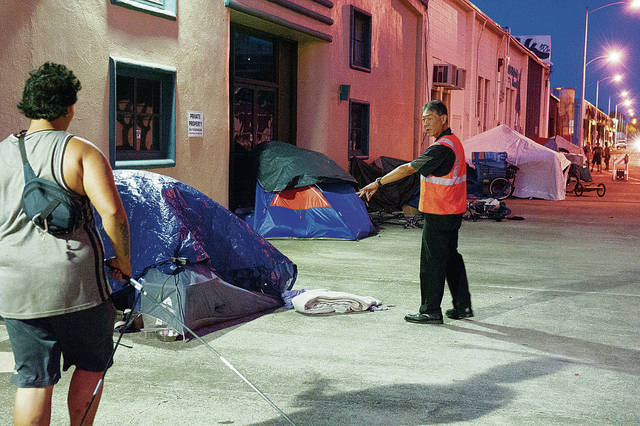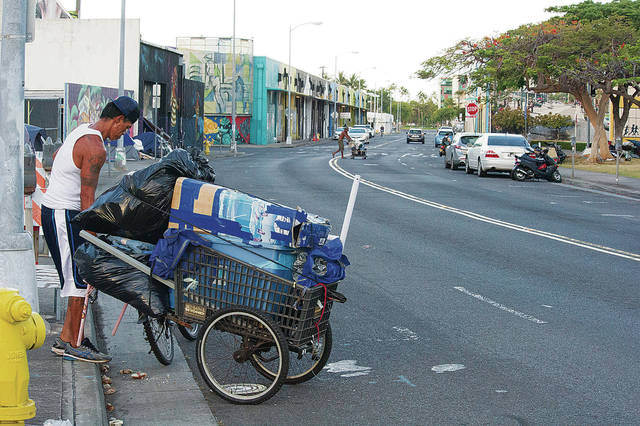Campers migrate daily from Kakaako sidewalks to Mother Waldron Park


CRAIG T. KOJIMA / CKOJIMA@STARADVERTISER.COM
ABC Stores employee Reed Ushiro coaxed a homeless man away from the front of the company’s Cooke Street headquarters Tuesday morning.

CRAIG T. KOJIMA / CKOJIMA@STARADVERTISER.COM
Homeless campers Tuesday morning headed from the front of ABC Stores’ headquarters across Cooke Street toward Mother Waldron Park.

CRAIG T. KOJIMA / CKOJIMA@STARADVERTISER.COM
Kakaako homeless move back to Mother Waldron Park as ABC Store employees arrive for work.




Marjorie Pua, an ABC Stores corporate office employee, parked her car off Cooke Street and sidestepped feces — maybe the result of animals, possibly human — as she entered the building Tuesday to start her workday.
“It’s like this every morning,” said Pua, an assistant in the graphic design department. “Every morning. It’s bad.”
After dozens of homeless people moved back into that part of the Kakaako neighborhood this month, ABC Stores had to buy a $300 power washer to clean feces away from its Cooke Street corporate headquarters, not to mention the hours of staff time spent every morning getting squatters to break down their tents and tarps.
That’s because at 10 each night, when nearby Mother Waldron Park closes, the homeless pack up their belongings and drag them to the Diamond Head side of Cooke Street to set up camp in front of ABC Stores’ corporate headquarters.
Then each morning, after the park reopens at 5 a.m., ABC Stores warehouse manager Mark Flores and assistant manager Reid Ushiro spend 90 minutes or more waking up people to ask them to clear the front of the building so employees can park their vehicles.
Flores is used to seeing a few homeless people around Mother Waldron Park. But, as people dragged their tents and tarps back across Cooke Street and into the park Tuesday morning, Flores said, “This is the biggest it’s ever been.”
Don't miss out on what's happening!
Stay in touch with breaking news, as it happens, conveniently in your email inbox. It's FREE!
ABC Stores has been headquartered on Cooke Street for 45 years, and company President and CEO Paul Kosasa took a long-term view of the current homeless population across the street.
“Forty-five years ago this area was just light industrial back then — warehouses, auto repair shops,” Kosasa said. “Now it’s Whole Foods, Nobu’s Restaurant, upper- scale condos. It’s improved a lot. So that’s a positive. But now you have this juxtaposition of poverty and wealth. It is an interesting society we live in now with a lot of Japanese tourists coming into Kakaako taking selfies of themselves in front of the art murals. You have these homeless encampments in front of art. It’s surreal.”
The 40 or so people and their dogs living in and around Mother Waldron Park — bordered by Pohukaina, Halekauwila, Cooke and Keawe streets — are mostly regulars, so-called chronically homeless who have been living on the streets around Kakaako for years.
Most of them migrated to the city park May 2 after the Hawaii Community Development Authority granted Honolulu police and a special city cleanup crew right of way to enter the state’s Kakaako Waterfront Park and its sister parks to enforce closure hours — which includes sweeping the homeless.
As a result, for the first time in years, there are no longer homeless encampments at Kakaako Waterfront Park and its adjoining parks, said Garett Kamemoto, HCDA’s interim executive director.
“On our side it’s been fine,” Kamemoto said. “The parks that HCDA owns are clear.”
But as years of city sweeps and sit-lie enforcements have shown, the homeless people who did not move into shelters or find permanent housing merely migrated into the adjoining neighborhood.
Those who made the walk across Ala Moana Boulevard to Mother Waldron Park include Totoa Totoa Jr. and his family.
In 2015 the Totoas had been living in one of America’s biggest homeless encampments — the sprawling community of more than 300 people around Kakaako Waterfront Park and the University of Hawaii medical school — when Totoa’s then-teenage son and one of his cousins were arrested for allegedly assaulting state Rep. Tom Brower (D, Waikiki-Ala Moana- Kakaako) as Brower photographed the encampment.
Totoa, 45, said Tuesday that his son now has a 3-year-old son of his own. Totoa said he also has a 1-year-old grandson.
“We did the shelter,” Totoa said as he broke down his encampment with a large knife and began to walk everything back into Mother Waldron Park.
Lina Lokot, 28, cradled her puppy, Mighty, as the dog gnawed on a teddy bear.
Lokot said she and her boyfriend, Marcelino Rofis, 50, have been cited five times this month at Mother Waldron Park for violations including not having her puppy on a leash and for possessing a structure with more than one wall, such as a tent, in the park.
Honolulu police, Lokot said, “have been giving us tickets up the ying-yang for $100 or more.”
Cherie Phillips, 67, was getting ready to drag her belongings back into the park, including a wheelchair and a tent outlined in several places with the word “Jesus” in black marking pen.
Phillips called being homeless in Honolulu “the most horrible experience you can imagine. People curse at me, say terrible things from the car. … They treat me really bad.”
Asked about the homeless occupants of Mother Waldron Park, Ross Sasamura, the city’s director of facility maintenance, said in a statement to the Honolulu Star- Advertiser:
“Crews from the Department of Facility Maintenance regularly enforce the Stored Property (SPO) and Sidewalk Nuisance (SNO) Ordinances at Mother Waldron Park and the surrounding streets in addition to other city parks and streets around Oahu. Scheduled enforcement actions are posted on the city website and any concerns relating to violations of the SPO and SNO may be reported by calling 768-4381.”
On the Ewa end of the park, Down to Earth Organic &Natural opened its Kakaako grocery store just five days before the city swept the parks around Kakaako Waterfront Park.
Dozens of homeless people have since set up camp next door.
“Nobody has caused any kind of trouble or problems with any of our customers or team members,” said Down to Earth spokeswoman Cynthia Cruz.
Down to Earth saw its Kakaako store as an opportunity in an area where auto body shops are giving way to multimillion-dollar condos on the edge of downtown.
“It’s the demographics,” Cruz said. “It’s a food desert. We wanted to service the new residents of Kakaako and also the downtown crowd. We already know that people think stores like ours are pricier, so we wanted to make sure we’re part of a residential/business place that appeals to both sides of the coin.”
Down to Earth also sees an opportunity to help homeless clients at the nearby Next Step Shelter makai on South Street — while developing new customers.
Food stamp clients cannot use their EBT cards to buy hot, prepared food at Down to Earth. So the company has led two cooking classes at the shelter using canned goods that can be found at Down to Earth, along with a store tour for Next Step clients.
The purpose, Cruz said, “is to show how to make some meals that aren’t too expensive. You can make a really good meal out of an inexpensive can of beans.”
Like other Oahu businesses, ABC Stores CEO Kosasa and his company have seen the effects of years of sweeps and laws aimed at the homeless.
Asked whether more sweeps are needed to clear Mother Waldron Park, Kosasa said, “No, I don’t think that’s the answer. The problem just moves around from one location to another location.”
Kosasa does not profess to have the answers, but said he thinks more money and emphasis need to go to helping and encouraging people to move off of places like Cooke Street.
“Funding has to go to more social work and mental health issues,” Kosasa said. “I don’t know what the solution is, but sending (the problem) to my neighbors or somebody else’s district doesn’t solve anything.”





